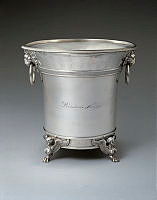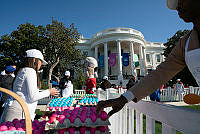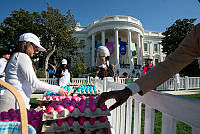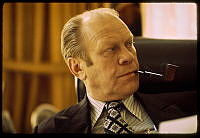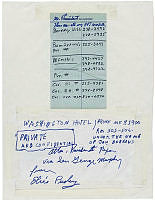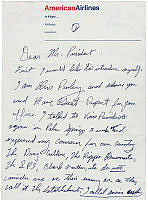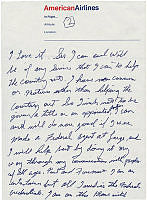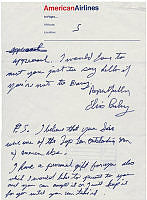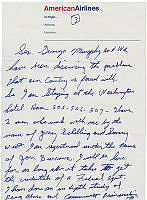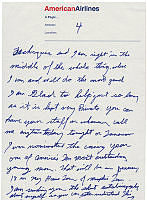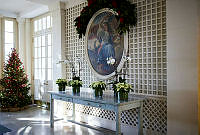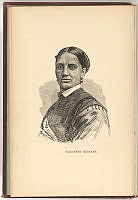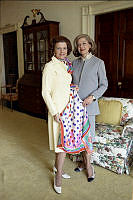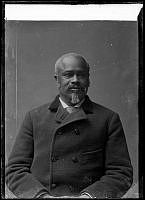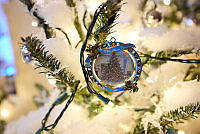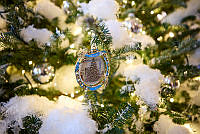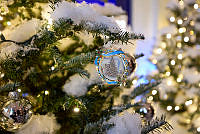The Working White House: First Family
Copyright © White House Historical Association. All rights reserved under international copyright conventions. No part of this article may be reproduced or utilized in any form or by any means, electronic or mechanical, including photocopying, recording, or by any information storage and retrieval system, without permission in writing from the publisher. Requests for reprint permissions should be addressed to books@whha.org
Gallery
-

First Lady Rosalynn Carter opens gifts from staff, 1977. When the Carters celebrated their 31st wedding anniversary, White House staff surprised them with the gift of a silver tray. From left: President Jimmy Carter, nursemaid Mary Fitzpatrick holding James Earl Carter IV, butler Eugene Allen, chef Henry Haller, butler Alfred Saenz, and maid Julia M. Sanders, with First Lady Rosalynn Carter and daughter, Amy, in front.
Jeff Carter -

Frankie Blair and Susan Ford wash the Fords’ golden retriever, Liberty, 1974.
David Hume Kennerly, Gerald R. Ford Presidential Library and Museum/NARA -

First Lady Barbara Bush with White House chefs at Christmas, 1992. White House pastry chefs Franette McCulloch (left) and Roland Mesnier pose with First Lady Barbara Bush in front of the elaborate gingerbread house they made for the holiday season.
George Bush Presidential Library and Museum/NARA -

Quentin Roosevelt and Roswell Pinckney seated on the White House steps in 1902. Theodore Roosevelt's youngest son, Quentin, enjoyed playing with Roswell, the son of steward Henry Pinckney. Quentin Roosevelt was killed in aerial combat during World War I. Roswell Pinckney worked for the U.S. State Department from 1917 until his retirement in 1960.
Library of Congress -

Winnie Monroe with the Hayes children, c. 1877. Winnie Monroe worked as a cook and nurse in the White House during the administration of President Rutherford B. Hayes.
Rutherford B. Hayes Presidential Center -

Inkwell, c. 1901. Prizefighter Robert Fitzsimmons, a close friend of President Theodore Roosevelt, had been trained as a blacksmith and enjoyed using his talents to create small mementos. He made this silver inkwell for the president, who in turn presented it as a souvenir to his trusted valet, James Amos. Amos counted it among his treasures for many years, eventually donating it to the Theodore Roosevelt birthplace in New York.
Lent by Theodore Roosevelt Birthplace National Historic Site -

Tip envelope, c. 1948. It was a longstanding White House tradition for workers to receive a gratuity from the first family at Christmas. Alonzo Fields recalled that President and Mrs. Hoover would give each employee “an autographed picture and an envelope with a crisp new $5 bill for servants of the lower bracket, and larger amounts for those of the higher brackets.” The size of the tip President Truman presented to Fields in this envelope is not known.
Lent by Mayland Fields
In the day-to-day life of the White House, interactions between the first family and the residence staff have varied widely. Theodore Roosevelt’s children counted on valet James Amos to umpire their baseball games. Lynda and Luci Johnson baked cookies in the White House kitchen. Mamie Eisenhower invited workers and their children to the Eisenhower farm in Pennsylvania; and many presidents and first ladies have hosted holiday parties for staff families. Whereas the Hoovers preferred that workers not use the elevator, Franklin Delano Roosevelt invited Lillian Rogers Parks, also a polio victim, to ride with him in the lift.
Staff memoirs are rich in detail about the atmosphere of the White House as a home and a workplace. Memoirs themselves symbolize relationships between their authors and the First Family. Dressmaker Elizabeth Keckly became the confidante of Mary Lincoln, who broke off the friendship when she discovered her letters included in Keckly’s 1868 reminiscences. Yet Eleanor Roosevelt actively urged Maggie Rogers to publish her White House memories; Harry Truman did the same for maître d’ Alonzo Fields. Conversely, Jacqueline Kennedy requested that staff refrain from publishing books about their White House years.
Over the years, workers have preserved written accounts, as well as photographs, invitations, notes of encouragement and appreciation, gifts, and mementos from presidents and first ladies. These documents and artifacts reflect the affinity between employer and employee.















